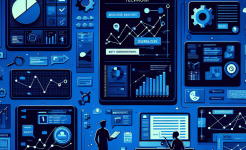Establish Clear Communication Channels
Clear communication is the foundation of any successful team collaboration. In an agile development setting, where multiple team members with different roles and responsibilities are working together, having well-defined communication channels is crucial. Firstly, establish regular team meetings. These can include daily stand-ups, where each team member briefly updates the group on their progress, any obstacles they've encountered, and what they plan to work on next. This quick and concise sharing of information keeps everyone in the loop and helps identify potential issues early on.
Secondly, utilize digital communication tools. Platforms like Slack or Microsoft Teams provide real-time messaging, file sharing, and the ability to create dedicated channels for different project aspects. This allows team members to communicate instantly, regardless of their physical location. For example, a developer can quickly reach out to a tester if they notice a potential bug during coding. Additionally, video conferencing tools such as Zoom or Google Meet are essential for more in-depth discussions, especially when face-to-face interaction is not possible.
Finally, document all communication related to the project. This includes meeting minutes, important decisions, and any discussions that could impact the project's direction. By keeping a record, new team members can easily catch up, and everyone can refer back to past conversations when needed. This documentation also serves as a valuable resource for auditing and knowledge transfer purposes.
Define Roles and Responsibilities Clearly
In an agile development team, each member plays a specific role, and it's essential that these roles and responsibilities are clearly defined. The product owner, for instance, is responsible for defining the product vision, prioritizing features, and representing the stakeholders' interests. They need to have a deep understanding of the market, the customers' needs, and the business goals. By clearly communicating the product roadmap and feature priorities, the product owner ensures that the development team is working on the most valuable tasks.
The development team, on the other hand, is in charge of writing code, implementing features, and ensuring the quality of the product. Developers need to have a good understanding of the technical requirements and be able to work together to build a robust and scalable solution. They should also be involved in the planning process, providing input on the feasibility of features and estimating the time required for implementation.
The tester's role is to ensure that the product meets the quality standards. They create test cases, execute them, and report any bugs or issues. Testers need to work closely with the developers to understand the functionality of the product and to ensure that all aspects are thoroughly tested. By clearly defining these roles and responsibilities, there is less room for confusion, and team members can focus on their specific tasks, leading to more efficient collaboration.
Foster a Culture of Trust and Respect
A positive team culture based on trust and respect is essential for effective collaboration. Trust allows team members to rely on each other, share ideas openly, and take risks without fear of criticism. To build trust, leaders should lead by example. They should be honest, transparent, and accountable for their actions. For example, if a leader makes a mistake, they should admit it and take steps to correct it. This shows the team that it's okay to make mistakes as long as they are learned from.
Respect for each team member's opinions, skills, and contributions is also crucial. In an agile environment, everyone's input matters, regardless of their position or seniority. Encourage open discussions and debates, where team members can share different perspectives. This not only leads to better decision-making but also makes team members feel valued and engaged.
Moreover, create a safe space where team members can express their concerns and challenges. If a developer is facing difficulties with a particular task, they should feel comfortable sharing it with the team. By providing support and assistance, the team can work together to overcome the problem, further strengthening the bond of trust and respect within the team.

Encourage Knowledge Sharing
In an agile development team, knowledge sharing is key to improving overall team capabilities. Each team member brings unique skills and experiences to the table, and by sharing this knowledge, the team can benefit as a whole. One way to encourage knowledge sharing is through knowledge transfer sessions. These can be formal or informal sessions where a team member with expertise in a particular area shares their knowledge with the rest of the team. For example, a developer who has experience with a new programming language can conduct a session to teach the basics to the other team members.
Another approach is to create a knowledge repository. This can be a shared document or a platform where team members can post articles, tutorials, and best practices related to the project. This repository serves as a valuable resource for everyone, allowing them to quickly access information when needed. Additionally, pair programming is an effective way to promote knowledge sharing. When two developers work together on a task, they can learn from each other's coding styles, problem-solving techniques, and best practices.
By encouraging knowledge sharing, team members can expand their skills and knowledge, which in turn improves the team's overall performance. It also helps in reducing the risk of knowledge silos, where certain team members have exclusive knowledge that others are not aware of.
Set Common Goals and Objectives
Having common goals and objectives is essential for aligning the efforts of the entire agile development team. The product owner, in collaboration with the team, should define clear and measurable goals for each sprint or project phase. These goals should be specific, achievable, relevant, and time-bound (SMART). For example, instead of setting a vague goal like "improve the product," a SMART goal could be "reduce the number of bugs in the product by 50% within the next sprint."
Once the goals are set, communicate them clearly to the entire team. Ensure that every team member understands how their individual tasks contribute to the achievement of these goals. This creates a sense of purpose and unity within the team. When everyone is working towards the same objectives, it becomes easier to coordinate efforts and make decisions.
Regularly review and update the goals as the project progresses. Agile development is iterative, and new information or changes in the market may require adjustments to the goals. By keeping the goals relevant and up-to-date, the team can stay focused and continue to work towards the overall success of the project.
Use Visualization Tools
Visualization tools can greatly enhance team collaboration in an agile development environment. These tools provide a clear and concise way to represent the project's progress, tasks, and dependencies. One of the most popular visualization tools in agile is the Kanban board. A Kanban board typically consists of columns representing different stages of the development process, such as "To Do," "In Progress," and "Done." Each task is represented as a card, which can be moved across the columns as it progresses.
The Kanban board allows team members to quickly see the status of each task, identify bottlenecks, and prioritize their work. It also provides a visual representation of the team's workload, making it easier to allocate resources effectively. Another useful visualization tool is the Gantt chart. Gantt charts show the timeline of the project, including the start and end dates of each task, as well as any dependencies between tasks. This helps the team plan and schedule their work, ensuring that all tasks are completed in a timely manner.
In addition to these tools, mind maps can be used to brainstorm ideas, define project requirements, and organize information. Visualization tools make it easier for team members to understand the project as a whole, communicate effectively, and collaborate more efficiently.
In conclusion, effective team collaboration is essential for the success of agile development projects. By establishing clear communication channels, defining roles and responsibilities, fostering a culture of trust and respect, encouraging knowledge sharing, setting common goals, and using visualization tools, teams can enhance their collaboration and achieve better results. These six tips work together to create an environment where team members can work together seamlessly, adapt to changes quickly, and deliver high-quality products in a timely manner. As the complexity of software development projects continues to increase, the importance of strong team collaboration in agile development cannot be overstated. Teams that embrace these principles and practices will be better positioned to succeed in today's dynamic and competitive business landscape. By continuously improving team collaboration, agile development teams can not only meet but exceed the expectations of their stakeholders, delivering products that drive business growth and innovation.
ARTICLE TITLE :Agile Development Flowchart: 6 Tips to Improve Team Collaboration ,AUTHOR :ITpmlib

















